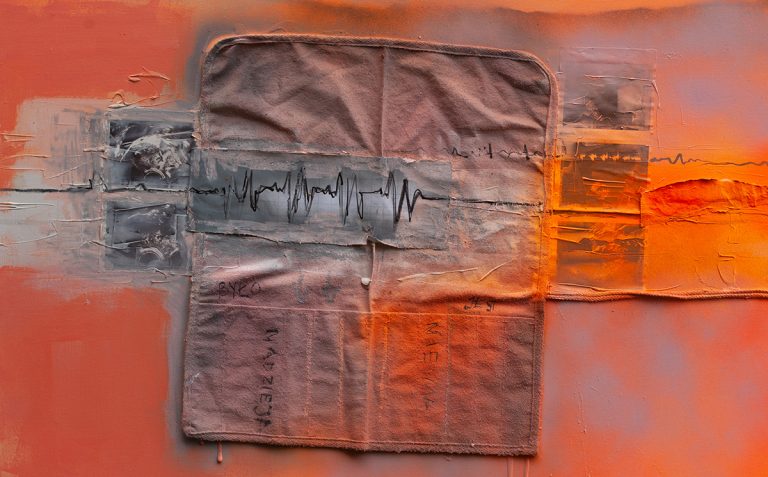Maria Husarska’s path as an artist began in Krakow, a city steeped in centuries of cultural heritage. She first trained at the High School of Fine Arts, where she earned a diploma in exhibition art. From there, she moved on to the Academy of Fine Arts in Krakow, studying painting under Professor Adam Brincken. Her early studies gave her a strong foundation in traditional technique, but her interests soon pushed her toward experimentation. In 2006, she completed her degree in the interdisciplinary studio of Professor Zbigniew Bajek with a project titled Horizont inside – outside. Alongside this, she created a photography annex titled Identity under Agata Pankiewicz, a sign of her early desire to move across mediums rather than remain bound to one. Her trajectory since then has been marked by this restless exploration, always pressing painting into conversation with other forms of expression.
The Beat of Heart
Her 2025 work The Beat of Heart (90×90, acrylic collage on canvas) is a continuation of that restless dialogue. At first glance, it reads as an abstract composition built from intense layers of orange, rust, and ash tones. The work resists a simple categorization. It is painting, but it is also collage. It is surface, but it is also depth. What anchors the work is not a single figure or image, but rather a pulse—something that seems to echo the irregular rhythm of life itself.
The center of the canvas features stitched or layered fabric pieces, folded and pressed into the surface. These carry drawn lines resembling an electrocardiogram, a heartbeat wave. It feels fragile, as if the canvas itself has been wired to register its own pulse. Husarska plays with this duality: the artificial graph of a machine and the raw, tactile material of fabric pressed into paint. The effect is uncanny. One feels both the science of measurement and the intimacy of touch.
The color field around the collage glows in warm, saturated orange. It radiates heat, almost like the afterimage of a sun setting behind the fabric. There is a tension between the mechanical signal and the organic glow of paint. This duality pulls the viewer inward, suggesting that the beat of a heart is both measurable and immeasurable, both a clinical fact and a mysterious force.
Material as Meaning
Husarska’s use of materials in this piece is critical. By collaging fabric directly onto the canvas, she breaks the traditional flatness of painting. The folds, seams, and textures interrupt the painted surface. These tactile qualities bring the work closer to the body. The fabric is not neutral—it carries memory. Stitched or worn, it reminds us of clothing, of skin, of protection, of fragility. In this sense, the fabric is not only a visual element but also a symbolic one. It embodies the vulnerability of the human condition.
The drawn heartbeat line across the fabric reinforces this. It runs horizontally, almost like a horizon, which recalls her early project Horizont inside – outside. But unlike the calm stability of a horizon, this line trembles, spikes, dips. It charts not a landscape but a life. Its interruptions remind us of fragility. At any moment, the line could flatten.
Between Inside and Outside
Husarska’s work often grapples with the idea of thresholds—between interior and exterior, between body and world, between one medium and another. The Beat of Heart extends this preoccupation. The stitched fabric forms a surface that feels both like a protective barrier and a vulnerable skin. The painted field around it glows with intensity, like the environment pressing in. The heartbeat line becomes a record of what passes between the two: the world outside and the life within.
The drips of paint that slide down from the collage are small but important. They pull gravity into the composition. They remind us that this is not just a symbol of life but a physical act of painting, subject to chance and flow. The drips connect the mechanical rhythm of the heartbeat with the uncontrollable rhythm of paint.
A Conversation with Time
Though abstract, the work feels deeply personal. It is not hard to see it as a meditation on survival, on the persistence of life in the face of uncertainty. The fabric, stitched and weathered, could be read as a stand-in for time itself—accumulating traces, folds, scars. The heartbeat line insists on presence, a fragile insistence that we are here, still breathing, still moving.
Husarska’s choice of orange and rust colors ties the work to a sense of fire and warmth but also to decay and ash. It vibrates between vitality and exhaustion, echoing the way a heartbeat itself is never static, always moving toward both renewal and eventual silence.
Conclusion
The Beat of Heart is not just an image; it is an event unfolding across a canvas. It speaks through texture, through heat, through rhythm. Maria Husarska has created a piece that is at once clinical and poetic, intimate and vast. It continues her long-standing interest in thresholds—inside and outside, surface and depth, measurement and feeling. What emerges is not just a painting but a meditation on life itself, as fragile and as luminous as the flicker of a heartbeat.

